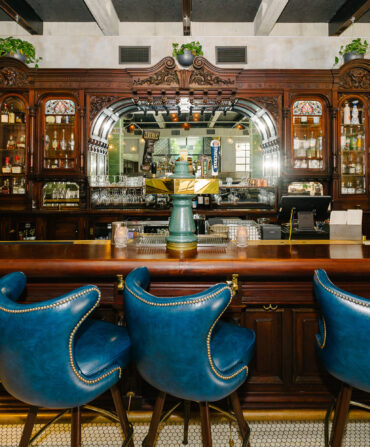As far as Deirdre and Phil Armstrong were concerned, the stand of black walnuts on the edge of their six-acre farm at Harvest Thyme Herbs in Staunton, Virginia, was a nuisance. The trees’ shallow roots played havoc with the mower, the nuts that rained down at harvesttime were an ankle-turning hazard, and then there was the aggravation of shelling the darn things. “They were the bane of our existence,” Deirdre says. Instead, the Armstrongs focused on cultivating herbs and chile peppers.
But Jeremiah Langhorne saw something different. “I’ve been visiting Harvest Thyme for ten years,” says the chef, who opened his Washington, D.C., restaurant, the Dabney, to acclaim late last year after a stint at Sean Brock’s McCrady’s in Charleston, South Carolina, where his foraged finds often ended up on the menu. “I’d gotten black walnuts before, so I knew about the trees, and I asked if I could gather some leaves.”
Langhorne traces his roots deep in the red-clay soil of the Shenandoah Valley, and he wanted his new restaurant’s menu to draw inspiration from native regional ingredients, including the black walnut. The stately trees shade neighborhoods in Washington, D.C., form enormous swaths of Great Smoky Mountains National Park, and dot woods as far west as Texas. While poring over a well-worn, claret-colored tome with a title that tells it all—Housekeeping in Old Virginia Containing Contributions from 250 of Virginia’s Noted Housewives, Distinguished for Their Skill in the Culinary Art and Other Branches of Domestic Economy—Langhorne found a recipe that intrigued him. There, on fragile pages between Mushroom Catsup and Walnut Catsup, were the curious instructions for Bay Sauce, made from the leaves of the black walnut tree. “You always hear about things made from the fruit,” Langhorne says, “but rarely the leaves.”
First printed in 1879 and reprinted dozens of times since, Housekeeping lists its contributors alphabetically in the front of the book. Three are named Langhorne, each related to the chef. “I thought it was interesting, and in some way, everything started to make sense—like why I am interested in cooking,” he says. “It was a nice bit of inspiration.”
The sauce has nothing whatsoever to do with the Old Bay Seasoning used on Chesapeake blue crabs, and like many nineteenth-century recipes, it offers room for interpretation. There are scant directions, amounts are measured by the handful, and instructions demand Bay Sauce spend time in the sunshine followed by a long rest. Langhorne gathered leaves a few times during the summer, layering them with a concoction of horseradish, onion, salt, and spices, then drowning it all in plenty of vinegar. For two weeks at a time, he mothered the jars, placing them outside to let sunlight and heat work their magic, then captured the sauce—mysterious, blackish, and funky—pressing the thick mash against a sieve and siphoning it into glass jars.
The first taste was “acrid, beyond bitter and so salty.” He wondered if it would ever be edible, so he set the jars in the refrigerator to rest. The sweet spot occurred six months in with young, green leaves gathered last June. Balanced and umami-rich, the result was reminiscent of Worcestershire sauce, though not as pushy—bright, acidic, briny, vinegary, but also deeper and woodsy. “It’s delicate now that it’s mellowed out,” Langhorne says. “Riding that bitter line, but with a great bite at the back of the throat.”
Start a batch now to have ready to sprinkle over next winter’s oysters. The flavor is well worth the wait. Or stop in at the Dabney, where Langhorne uses Bay Sauce widely in dressings for vegetables, sauces for fish and shellfish, and in a particularly lovely beurre blanc that puddles luxuriously around rockfish. It’s a dish 137 years in the making.








